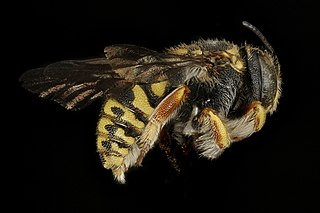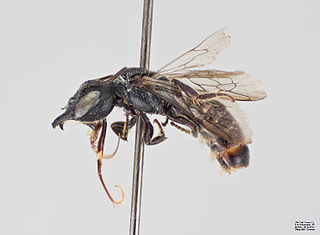
Megachilidae is a cosmopolitan family of mostly solitary bees. Characteristic traits of this family are the restriction of their pollen-carrying structure to the ventral surface of the abdomen, and their typically elongated labrum. Megachilid genera are most commonly known as mason bees and leafcutter bees, reflecting the materials from which they build their nest cells ; a few collect plant or animal hairs and fibers, and are called carder bees, while others use plant resins in nest construction and are correspondingly called resin bees. All species feed on nectar and pollen, but a few are kleptoparasites, feeding on pollen collected by other megachilid bees. Parasitic species do not possess scopae. The motion of Megachilidae in the reproductive structures of flowers is energetic and swimming-like; this agitation releases large amounts of pollen.

Megachilinae is the largest subfamily of bees in the family Megachilidae. It includes mason bees, leafcutter bees, and carder bees.

Heriades is a genus of bees in the family Megachilidae. Fairly small and usually black, they are found all over the world. There are more than 130 species worldwide, roughly 25 species in North and Central America, but only 3 species are native east of the Rocky Mountains. European species such as H. truncorum can be found on the east coast of the US. Like other bees in the tribe Osmiini, Hoplitis and Ashmeadiella, they nest in cavities in wood excavated by other insects, or perhaps occasionally pine cones. They separate the cells of their nest with resin .

Osmiini is a tribe of leafcutter, mason, and resin bees in the family Megachilidae. There are about 19 genera and at least 1,000 described species in Osmiini.
Ashmeadiella bigeloviae is a species of bee in the family Megachilidae. It is found in Central America and North America.

Ashmeadiella is a genus of bees in the family Megachilidae. There are more than 60 described species in Ashmeadiella.

Ashmeadiella xenomastax is a species of bee in the family Megachilidae. It is found in Central and North America.

Hoplitis is a genus of bees in the family Megachilidae. There are more than 380 described species in Hoplitis.
Chelostoma californicum is a species of bee in the family Megachilidae. It is found in Central America and North America.
Hoplitis biscutellae is a species of bee in the family Megachilidae. It is found in Central America and North America.

Anthidiellum ehrhorni is a species of bee in the family Megachilidae. It is found in Central America and North America.

Osmia texana, the Texas osmia, is a species of bee in the family Megachilidae. It is found in Central America and North America.

Osmia georgica is a species of bee in the family Megachilidae. It is found in Central America and North America.
Stelis diversicolor is a species of cuckoo bee in the family Megachilidae. It is found in Central America and North America.
Ashmeadiella rubrella is a species of bee in the family Megachilidae. It is found in Central America and North America.
Hoplitis bullifacies is a species of bee in the family Megachilidae. It is found in North America.
Osmia cyanella is a species of bee in the family Megachilidae. It is found in North America.
Osmia dakotensis is a species of bee in the family Megachilidae. It is found in North America.
Osmia botitena is a species of bee in the family Megachilidae. It is found in North America.

Protosmia rubifloris is a species of bee in the family Megachilidae. It is found in Central America and North America.








